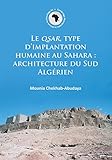Le qsar, type d'implantation humaine au Sahara : architecture du sud algérien
Par: Chekhab-Abudaya, Mounia (1985-....) [Auteur].
Type Document : Ouvrage Collection: Cambridge monographs in African archaeology.Editeur: Oxford : Archaeopress, 2016Description Matérielle: (XIV, 339 p.) : cartes, plans, ill., couv. ill. en coul. ; 30 cm.ISBN: 978-1-78491-347-2; 1-78491-347-2 .Mots Clés: Ksour -- Sahara (Algérie) | Architecture -- Sahara (Algérie) | Villes -- Sahara (Algérie) | Établissements humains -- Sahara (Algérie) | Sahara (Algérie)Résumé: The qsar corresponds to a type of human settlement widely distributed in the Sahara desert, including many examples located today in southern Morocco, southern Algeria, southern Tunisia, Libya, Mauritania and Mali. This architectural model is characterised by its use over a wide-ranging time span - probably since the early first millennium BC according to ancient structures recorded by the archaeologist Mattingly in the Libyan Fazzan. This volume, through the systematic analysis and comparison of some qsur of southeastern Algeria (Rig, Mzab, Miya and al-Mani'a), reveals common architectural features that can be used to identify a common type of qsar in this region. The analysis of the construction material shows the primary use of limestone with a local mortar (timchent) and date palm trunks (phoenix dactylifera) for the structural elements (ceilings, doors, arcs, domes). Adobe bricks (tub) are used in the housing and the defence systems punctuated by towers and pierced doors. Despite a discontinuity within the historical narrative, the establishment of populations in this area of the Sahara appears to be much earlier than the medieval period and the q?ar is certainly not a creation ex nihilo of the modern era. Because of their numerous modifications and extensions over several centuries, the qsur problematise the dating of such settlements. However, the comparison of its main components encourages the development of a typology to identify some common characteristics that would help position the qsar among the urban planning of the dar al-islam.Sommaire:| Type de document | Site actuel | Cote | Statut | Notes | Date de retour prévue | Code à barres | Réservations |
|---|---|---|---|---|---|---|---|
 Ouvrage
Ouvrage
|
Bibliothèque Centrale | 03040111001 (Parcourir l'étagère) | Disponible | 3.2 | 03040111001 | ||
 Ouvrage
Ouvrage
|
Bibliothèque Centrale | 03040111002 (Parcourir l'étagère) | Disponible | 3.2 | 03040111002 |
Bibliogr. p. 327-339
The qsar corresponds to a type of human settlement widely distributed in the Sahara desert, including many examples located today in southern Morocco, southern Algeria, southern Tunisia, Libya, Mauritania and Mali. This architectural model is characterised by its use over a wide-ranging time span - probably since the early first millennium BC according to ancient structures recorded by the archaeologist Mattingly in the Libyan Fazzan. This volume, through the systematic analysis and comparison of some qsur of southeastern Algeria (Rig, Mzab, Miya and al-Mani'a), reveals common architectural features that can be used to identify a common type of qsar in this region. The analysis of the construction material shows the primary use of limestone with a local mortar (timchent) and date palm trunks (phoenix dactylifera) for the structural elements (ceilings, doors, arcs, domes). Adobe bricks (tub) are used in the housing and the defence systems punctuated by towers and pierced doors. Despite a discontinuity within the historical narrative, the establishment of populations in this area of the Sahara appears to be much earlier than the medieval period and the q?ar is certainly not a creation ex nihilo of the modern era. Because of their numerous modifications and extensions over several centuries, the qsur problematise the dating of such settlements. However, the comparison of its main components encourages the development of a typology to identify some common characteristics that would help position the qsar among the urban planning of the dar al-islam.

